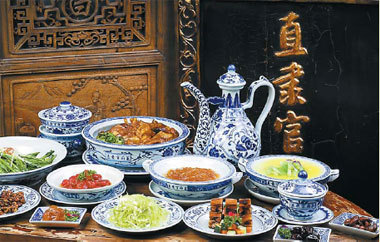
What is it that makes a local cuisine intangible cultural heritage? It could only be a profound history and cultural background, and great culinary skills. Opened last month, Zhili Native Association (直隶会馆) brings something new to Beijing palates - Hebei cuisine, presented with unique ancient Chinese cultural and culinary flair.
Zhili is a term in ancient China referring to jurisdictional regions directly under Beijing. Later it evolved to refer to the regions in and around Hebei province. In Qing Dynasty (1644-1911), Zhili was once enlarged to include not just Hebei, but also part of Northeast China's Liaoning, and Inner Mongolia.
The restaurant well matches its publicity motto: "an edible museum". The seven-floor restaurant is built in ancient Chinese architectural style, with grey bricks, wooden frames, Ming and Qing dynasty furniture, and metal works. The restaurant has professional guides to explain the culture and stories behind the decorations and cultural relics displayed.
Two underground levels resemble an ancient theater restaurant, with a stage platform, and dining tables in front of the stage. Traditional Chinese performances will soon be staged. In private rooms on a higher level, with good views of the stage, ancient cultural relics are displayed behind windows. There are patent plates and bowls, ancient government official's clothing, traditional Chinese stone stamps carved by masters in Hebei province, and samples of the most famous delicacies of the Chinese cuisine.
Each floor has a different theme. Private rooms on the third floor are named after famous historical characters in China. Rooms on the fourth floor are named for different jurisdictional regions in the ancient region of Zhili. The fifth floor uses names associated with Peking University, which is next to the restaurant building.
Hebei cuisine is famous for its dishes quick fried with salty soybean paste, which tastes not as sweet as Beijing soybean paste. The soybean paste has been famous in Baoding of Hebei for more than 300 years. Zhili Native Association uses a clear broth in its dishes, made with hours of simmering, comprising chicken, pork, ham and beef.
The dishes are served with the restaurant's patent plates and bowls (pictured), which are called "warming plate" and "warming bowl", because they are ingeniously designed to have a hollow center with hot water to warm the dish. In summer, the hollow part can be filled with ice to cool the dish down. The paste, the broth, and the tableware helped the restaurant's cuisine obtain intangible cultural heritage recognition in Hebei in 2006.
Recommended dishes include fried shelled prawn with diced chicken in soybean paste (鸡里蹦), deep-fried pork leg cake with pancake and paste, served much in the way of Peking roast duck (锅包肘子), chilled peeled cherry tomato (蜜汁小番茄), Zhili meatball(南煎丸子), and Li Hongzhang's assorted stewed dish(李鸿章烩菜).
Average spending for a formal dinner is around 300 yuan per person. Menu is in both Chinese and English, with color illustration.
Ye Jun
11am-2pm, 5-9pm. 127 Zhongguancun Beidajie. Opposite west gate of Tsinghua University, on the north side of the street. 6276-2828. 海淀区中关村大街127号,清华大学西门斜对面
(China Daily February 23, 2008)